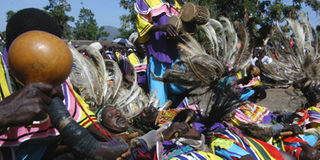Premium
Nilotes or Bantus? Debate rages as the Suba face identity threat

Photo/JACOB OWITI/NATION
Kagan cultural dancers from Kochia, Homa-Bay County.
Mzee Apollo Okeyo is a worried man. He leads a people who have been officially declared endangered.
History books call his people the Luo-Abasuba, meaning they are part of the Nilotic Luo. But they say they are Bantu, and therefore cannot be a sub-group of Nilotes.
Mr Okeyo is chairman of the Abasuba council of elders. In their dying language, he is known as the omogambi.
“Eighty-five percent of our people do not speak the language; intermarriage with the Luo has contributed to our demise. People think that you are more civilised when you speak dholuo than basuba”, he said.
Although the Abasuba have existed for centuries, they had the Bible published in their language only this year.
Their music is confined to the older men and women who hum it to pass time as they toil in the field. Their young dance to ohangla and benga in the villages.
According to community elder Mzee Acholla Gaa their association with the Luo, “is a misinterpretation of history”.
He said, “We are Bantu people with no common historical or cultural origin with the Nilotes, hence the name Luo-Abasuba is a gross misinterpretation of the Abasuba community and borders on insult and colonisation”.
And they take offence that politically too they have been lumped with the Luo, “who take up the lion’s share of the political cake.”
Mr Okeyo, the omogambi said, “We are about 300,000. We have to be given our due recognition”.
He complained that their own political class, including Immigration Minister Otieno Kajwang’ were comfortable with being lumped together with the Luo.
Mzee Gaa admitted that facts and dates about the Abasuba were hard to come by, because many were not documented.
“The origin and history of the Abasuba is largely based on oral history. Chronology of events may therefore be a bit inaccurate,” he explained.
But Mzee Gaa argued that their origin pointed towards the Buganda Kingdom and said the Abasuba arrived in Kenya by crossing Lake Victoria, using its many islands as stepping stones.
The claim of the links with Buganda is supported by the fact that both peoples call God Katonda and both call their women omukazzi.
To support the claim that they are not related to the Luo, Mr Okeyo said the Luo alphabet did not have letters z and v.
“Because of the Luo domination, they have corrupted out language to fit into the Luo setting,” he said. Modern day Mbita was Emvita in Basuba, which means a water passage.
Rusinga was Eluzinga, the Basuba word for an island. Takwari, the name of one of the islands, means a swollen place on the lake.
Currently the Abasuba occupy many islands on the lake from the Southern border with Tanzania up to Basuba district which borders Bondo, Rarieda, Homa Bay and Migori. Some live around Gwassi Hills which borders Ruma National Park.
But if they are a distinct group, why have they been assimilated so fast while other small peoples such as the Ogiek maintain their identity?
Mr Okeyo attributes it to education, a general inferiority complex, and intermarriage. He said with the advent of the modern education, the medium of communication for the first classes was mother tongue.
The Abasuba did not have teachers so their children were taught by Luos. “Gradually all those who went to school started speaking Dholuo because they thought it was being taught in school because of its superiority over their own language,” Mr Okeyo explained.
He added that many of their Luo neighbours referred to them as jomwa, meaning foreigners, which did not please a majority of the Abasuba, who decided to learn Dholuo to fit in.




